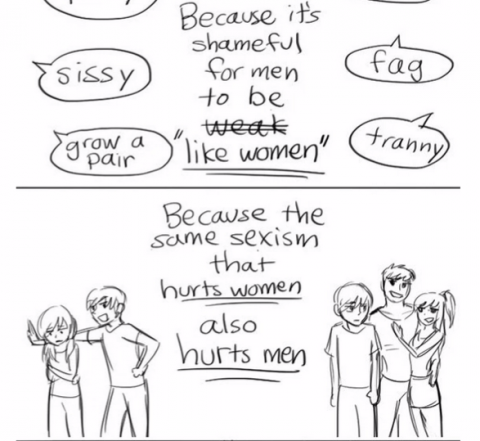Is the world still sexist?
Jun 30,2015
Benevolent vs. Hostile Sexism
Sexism is an attitude, which means that it can be expressed as a thought, an emotion, or an action that shows a bias toward one sex over the other. All people exhibit some bias, but this bias can be unconscious or suppressed so that it is covert, while it is less common than it was even 20 years ago to see overt demonstrations of sexism. In situations in which sexism is prevalent, it is usually demonstrated as hostile sexism toward men and benevolent sexism toward women, as http://www.understandingprejudice.org/asi/ demonstrates. This means that men are seen as strong and powerful physically and therefore threatening, while women are seen as beautiful and gentle physically and therefore weak and to be protected. Hostile sexism is overtly negative while rewarding men for being "active (i.e. using force) while benevolent sexism is covertly negative and rewards women for being "passive." On the other hand, hostile sexism punished women for being active, whereas benevolent sexism rewards men who may not have physical strength for being rich or desirable.
Modern Sexism Revealed & Stereotype Threat
Modern sexism emerges unconsciously through the Implicit Association Test, which tests how strongly one views the relationship between two words, such as “female” and “mother.” It emerges consciously through stereotypes and sexist jokes, which are more appropriate in society because of the lack of seriousness surrounding them. We have a tendency to view stereotypes and jokes as harmless because we know that they are not true, but this is not the case, as studies show. A phenomenon known as “stereotype threat” has been known to decrease performance in all populations, not just so-called “protected” populations like minorities and women. In one study, white men performed worse than African American men at mini golf when told that they were being tested on “natural ability,” and they also performed worse than Asian men on a math test when given a stereotype prompt. When reminded of the Asian stereotype, Asian women performed better on a math test than when they were prompted with a female stereotype. However, studies shows that people perform better when they are reminded that nervousness is normal on a test because studies indicate that they feel that poor performance will reflect poorly on their stigmatized population and that they attribute anxiety to inability to perform. Also, it helps to think of oneself as part of a less-stigmatized group, like one’s university.
Problematic Attitudes about Gender
The sexist attitude has branched out into a prejudice against other groups because of the rigid social boundaries concerning gender and the pressure from social cues like advertising to conform to a hyper-masculine or hyper-feminine image. We often blame this on the mass media, but Malcolm Gladwell’s The Tipping Point indicates that these cues can be as subtle as the graffiti on a wall can trigger a crime epidemic. It is tempting to think that all of the social pressure lies on women to be beautiful and thin, but we forget that anorexia also affects men, who may feel pressure to be equally as attractive to women. We forget that while the pressure lies on women to be chaste, the pressure lies on men to be experienced sexually. Thus, our ideas about gender may make us confused when it comes to the LGBT community, which requires support as an even more stigmatized group.
From Sexism to Equality
One way to avoid sexism (and prejudice toward any group) is to attribute a person’s faults to the situation rather than that person’s population, a tendency broadly referred to as the ultimate attribution error. Another way is to treat a person of about whom you have a negative attitude neutrally. Studies have found that your unconscious attitudes can influence your behavior towards another person, which in turn can impact that person’s behavior toward you and validate sexist attitudes. Finally, try not to look for evidence that your bias is justified, as we often tend to do because we see what we want to see and you will be able to find evidence to support either side.
References
image credit to MemeCollection.net
Aronson, J., Lustina, M. J., Good, C., Keough, K., Steele, C. M., & Brown, J. (1999). When white men can't do math: Necessary and sufficient factors in stereotype threat. Journal of experimental social psychology, 35(1), 29-46.
Becker, J. C., & Swim, J. K. (2015). Reducing endorsement of benevolent and modern sexist beliefs. Social Psychology.
Cunningham, G. B., & Melton, N. (2012). Prejudice against lesbian, gay, and bisexual coaches: The influence of race, religious fundamentalism, modern sexism, and contact with sexual minorities. Sociology of Sport Journal, 29(3), 283-305.
Gladwell, M. (2000). The tipping point: How little things can make a big difference. Boston: Little, Brown.
Glick, P., Wilkerson, M., & Cuffe, M. (2015). Masculine Identity, Ambivalent Sexism, and Attitudes Toward Gender Subtypes. Social Psychology.
Greenwald, A. G., Banaji, M. R., & Nosek, B. A. (2015). Statistically small effects of the Implicit Association Test can have societally large effects.
Gueguen, J., Godart, N., Chambry, J., Brun‐Eberentz, A., Foulon, C., Snezana, M., ... & Huas, C. (2012). Severe anorexia nervosa in men: comparison with severe AN in women and analysis of mortality. International Journal of Eating Disorders, 45(4), 537-545.
Hart, J., Glick, P., & Dinero, R. E. (2013). She Loves Him, She Loves Him Not Attachment Style as a Predictor of Women’s Ambivalent Sexism Toward Men.Psychology of Women Quarterly, 0361684313497471.
Spencer, S. J., Steele, C. M., & Quinn, D. M. (1999). Stereotype threat and women's math performance. Journal of experimental social psychology, 35(1), 4-28.
Shih, M., Pittinsky, T. L., & Ambady, N. (1999). Stereotype susceptibility: Identity salience and shifts in quantitative performance. Psychological science,10(1), 80-83.
Steele, C. M. (1999). Thin ice:" Stereotype threat" and Black college students.ATLANTIC-BOSTON-, 284, 44-54.
Raymond, J. (2013). Sexist attitudes: Most of us are biased. Nature, 495(7439), 33-34.






